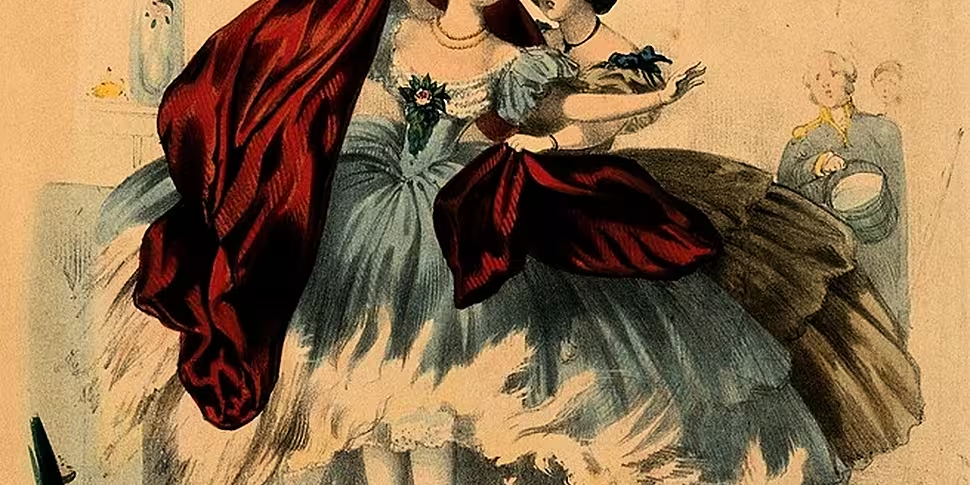If you take a stroll through Père Lachaise cemetery in Paris, where Jim Morrison, Molière, and Édith Piaf are buried, one of the most visited graves of them all is the tomb of Oscar Wilde.
The stone monument, carved over ten months by the sculptor Jacob Epstein, depicts a winged figure inspired by a line from Wilde’s poem of The Sphinx, “sing me all your memories.” For decades, thousands of visitors flocked to the grave, many of them kissing the Hopton Wood stone to leave behind a puckered print in lipstick. There are no such markings on one modest headstone of St Molua’s Church in Drumsnat, Monaghan, where Wilde’s forgotten half-sisters lay buried. Etched onto gravestones are the words: In memory of two loving and loved sisters, Emily, aged 24, and Mary, aged 22, who lost their lives by accident in this parish, Nov 10th 1871. They were lovely and pleasant in their lives. And in their deaths they were not divided.”
While so much is known about their famous brother, very little has been told about his pitiable sisters, who died after succumbing to their injuries after a freak accident on Halloween, 1871. Neither Emily nor Mary were the first sister that Oscar would lose, with Isola, aged just 10, dying after contracting a fever when the future playwright and internationally adored wit was only 12.
Whether or not Wilde even knew of Emily and Mary is much disputed, given that they were the illegitimate daughters of his father, the celebrated surgeon Sir William Wilde. Indeed, only one newspaper in Ireland, the Monaghan local Northern Standard, carried the news of their passing in a very brief obituary on November 25th, not in keeping with a fine and upstanding family of the Dublin Victorian scene.
Typically, the passing of two daughters, especially in such bizarre circumstances, would have been reported far and wide, but it was hastily covered up, despite the fact that Sir William attended their funeral, and his mourning “could be heard by people outside his house”.
Emily and Mary Wilde had been sent by their father to stay in Monaghan with their relative, Rev Ralph Wilde, and had been boarding with the local Rector. By all – admittedly limited – accounts, they were an instant hit on the provincial scene, and a ball was thrown in their honour to welcome their arrival in Drumsnat. That ball would take place on Halloween night in Drumaconnor House, with the Wilde sisters falling victim to a deadly plague of the era – Crinolinemania.

A cartoon depicting a Crinoline factory, showing the hoop frames that supported billowing skirts [Wikipedia Commons]
Crinoline was the most fashionable trend in ladies attire, peaking in the mid 1800s with a decade that claimed the lives of 3,000 women in Britain and Ireland. The name is a blend of ‘crin’, the given term for a stiff but pliant material made of horse hair, and linen. Crinolinemania was all about creating an impossibly puffed-out silhouette, with long skirts bulging out in antisocial diameters, interconnected under-hoops turning dresses into engineering feats similar to blimps. But much like the gas-filled airships, Crinoline was a major fire hazard, catching and engulfing women by the thousands between the late 1850s and late 1860s.
Emily and Mary Wilde would suffer that fate. The story goes that on Halloween night, towards the end of the ball, almost all of the guests had made their way home. Andrew Nicholl Reid, the sisters’ host, asked Emily for a final waltz across the floor. Spinning past an open fireplace, Emily’s Crinoline skirt brushed off the dying embers, immediately catching alight. Mary, seeing her sister’s terrified screams and the flames overtook her, ran to Emily’s aid, only for her own clothes to start burning as well.
Eyewitness reports differ on what happened next. In one account, the sisters stumbled around in utter panic, falling down a set of steps while onlookers rushed to throw water on them. Another suggests that the gallant Reid wrapped his coat around the sisters, ushering them out into gardens where the fire was extinguished by the – almost certainly apocryphal – snow on the ground.

The grave shared by Emily and Mary Wilde in St Molua's Church in Monaghan [Wiki Commons]
Burned all over, the Wilde sisters were cared for over the agonising days it took them to pass away. Mary went first on the 8th, but Emily held on to life for three weeks before finally fading away on November 21st. To save their father the social embarrassment of having his illegitimate children splashed across the pages of newspapers, Sir William Wilde reportedly wrote to the County Monaghan Coroner after Mary’s death, pleading with him to save Emily – or the family name.
“Doing so,” Sir William wrote, referring to recording Mary’s name in the Inquisition Book, “might be of fatal consequences to deceased’s sister, who is dangerously ill from severe burns caused to her while endeavouring to extinguish the burning clothes of her sister.”
As such, she was recorded as Miss M Wylie. When Emily passed two weeks later, Miss L Wylie’s death required no further examination. The sisters were buried, with their real names, by the local Church of Ireland clergyman, Rev Thomas Le B Kennedy.
A Mrs Himes, identified by Jack Butler Yeats in a letter to his son William decades later, had been a friend of the Wildes, reportedly told him that Mary and Emily’s mother had been with them when they died. Indeed, Eleanor Fitzsimons, writer of Wilde’s Women, says there is a local story told in Drumsnat that a mysterious ‘lady in black’ made regular journeys by train from Dublin to Monaghan, taking a carriage to the St Molua graveyard to stand in silent vigil at their headstone. When a groundsman asked her once how she knew the Wilde sisters, she simply replied they had been very dear to her. As Fitzsimons writes, “although the identity of this veiled woman was never discovered, she was almost certainly the same, ‘woman dressed in black and closely veiled’ who arrived at William’s bedside five years later when he lay dying.”









